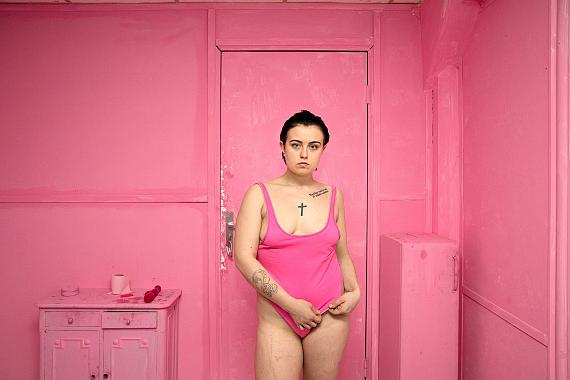
Agata
Paris, France, November 2, 2017
© Bieke Depoorter/ Magnum Photos (in collaboration with Agata Kay)
Courtesy of the artist
Deutsche Börse Photography Foundation Prize 2023
shortlist
Bieke Depoorter » Samuel Fosso » Arthur Jafa » Frida Orupabo »
Exhibition:
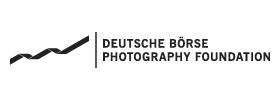
Deutsche Börse Photography Foundation
Mergenthalerallee 61
65760 Eschborn
+49 (0)69-21 11 40 60
foundation@deutsche-boerse.com
deutscheboersephotographyfoundation.org/
by app. only
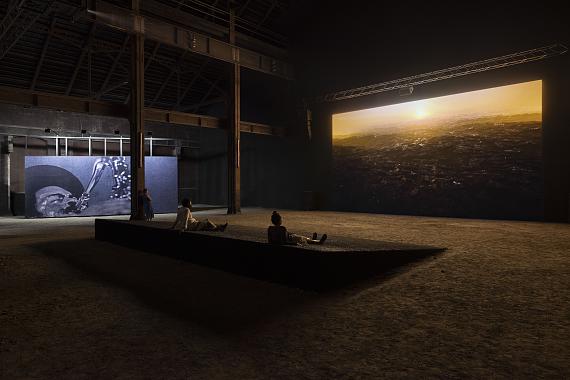
Arthur Jafa: LIVE EVIL, LUMA Arles, France April 14 – November 14, 2022
© Arthur Jafa
Courtesy of the artist, LUMA Arles, and Gladstone Gallery. Photography by Andrea Rossetti
Deutsche Börse Photography Foundation Prize 2023 shortlist
Bieke Depoorter, Samuel Fosso, Arthur Jafa, Frida Orupabo
The four international artists shortlisted for the Deutsche Börse Photography Foundation Prize 2023 are: Bieke Depoorter, Samuel Fosso, Arthur Jafa and Frida Orupabo.
Originally established in 1996 and organised in partnership with the Photographers’ Gallery in London, since 2016, this long-standing and influential annual Prize identifies and rewards artists and their projects considered to have made the most significant contribution to photography over the previous 12 months.
Over its 26-year history, the Prize has become renowned as one of the most important international awards for photographers, as well as a barometer of photographic development, foregrounding outstanding, innovative and thought-provoking work. From blurring the relationship between photographer and subject and unpicking the ethics of being a photographer, to exploring gender and sexuality, violence, injustice and the Black experience, this year’s shortlisted artists all push the boundaries of photography and exemplify its resonance and relevance as a cultural force today.
The annual exhibition of shortlisted projects will be on show at The Photographers’ Gallery, London, from 3 March – 11 June 2023.
The winner of the £30,000 Prize will be announced at an award ceremony held at The Photographers’ Gallery on 11 May 2023, with the other finalists each receiving £5,000. Full details on the Prize exhibition and award evening will be announced in early 2023.
The 2023 shortlisted artists and projects are:
Bieke Depoorter – for her exhibition "A Chance Encounter" at C/O Berlin (30 April – 7 September 2022)
In an exhibition of installations, projections, film and photography, Bieke Depoorter (b. 1986, Kortrijk, Belgium) blurs the traditional relationship between photographer and subject. The exhibition presents two unfolding, ongoing, bodies of work, "Agata" and "Michael". Here, a chance encounter develops into an enduring personal relationship and, thereafter, into an interrogation of the medium.
In "Michael", Depoorter examines the life and the disappearance of a man she met on the streets of Portland, Oregon, in 2015. Gifted three suitcases of Michael’s personal items, sketchbooks and essays, Michael’s subsequent disappearance turns Depoorter detective. The exhibition documents Depoorter’s immersive, perhaps obsessive, quest to find Michael and to understand his life.
In "Agata", both as an exhibition and a self-published book, a first meeting in a Parisian strip-club in 2017 evolves with complex tension into an exercise in collaboration. Here the images and words of Agata Kay are in taut dialogue with Depoorter’s images and letters. They offer not conclusions or endings but a living visual changing narrative that explores concepts of authentic versus performative identity; the potential impossibility of truth in representation; artistic authorship; photographic ethics; the responsibilities of the photographer; personal boundaries; and the limits of a creative friendship.
Samuel Fosso – for his exhibition "Samuel Fosso" at the Maison Européenne de la Photographie, Paris (10 November 2021 – 13 March 2022)
Since the mid-1970s, Samuel Fosso (b. 1962, Kumba, Cameroon) has dedicated his artistic practice to self-portraits and performative photography. Fosso’s retrospective exhibition traces a career of almost 50 years and comprises more than 300 prints. The exhibition brings together iconic series, lesser-known works, as well as archival material and previously unpublished images, displayed principally in large-scale ensembles.
Born in Kumba, Cameroon, and raised in Nigeria, Fosso fled the Biafran War as a young boy, and in 1972 was taken in by an uncle in Bangui in the Central African Republic. In 1975, at the age of thirteen, Fosso opened his Studio Photo Nationale. Alongside commercial work, Fosso immediately began a series of self-portraits – a mode of representation he has never abandoned. Playing the role of key historical figures and social archetypes in front of the camera, Fosso embodies a powerful way of existing in the world, and a vivid demonstration of photography’s role in the construction of myths.
Arthur Jafa – for his exhibition "Live Evil" at Luma, Arles (14 April – 13 November 2022)
Arthur Jafa (b. 1960, Tupelo, USA) is an artist and filmmaker. Nominated for the largest and most comprehensive exhibition of his work to date, Jafa draws upon a substantial archive of film and still images, creating visceral, dynamic films and room-sized installations.
In the gallery space and on the screen, Jafa derives power from astute juxtaposition and lyrical, syncopated editing. Here the role of his personal archive and his instinct as a collector of images comes to the fore. Since the 1980s, Jafa has been accumulating and assembling pictures from books and magazines, arranging this imagery in new constellations within notebooks and latterly within dynamic artworks. For ready-made moving images, YouTube remains a favourite resource, alongside news footage and home video.
It is by placing one resonant cultural artefact next to another that Jafa references and questions the universal and specific articulations of Black experience. Eschewing a linear narrative, Jafa organises his material through formal and affective associations, linking his images through visual resemblance or thematic resonance. In this way, Jafa aspires to an art that harnesses "the power, beauty, and alienation of Black music."
Frida Orupabo – for her exhibition "I have seen a million pictures of my face and still I have no idea", at Fotomuseum Winterthur (26 February – 29 May 2022)
The sculptural collages and digital works of Frida Orupabo (b. 1986, Sarpsborg, Norway) are multi-layered formations, exploring questions of race, sexuality and identity. Orupabo, a Norwegian Nigerian artist and sociologist, grounds her inquiry in her own experience of cultural belonging.
Utilising visual material circulating online, spanning colonial-era photographs and ethnographic relics to contemporary imagery, Orupabo’s hand-wrought works re-arrange and re-make the archive. The resulting images take the shape of fragmented Black, mostly female-bodied, figures. These figures, first dislocated, are reassembled layer by layer in a complex and poetic manoeuvre that simultaneously denounces one-dimensional depictions of Black lives. Orupabo bestows complexity, ambivalence and contradiction. Her collaged cut-outs hold our gaze and invite various readings of the stories and lives of the people depicted, many of whom are entirely absent from the archives. In this way Orupabo invites a consideration of how photography significantly contributes to the formation and perpetuation of colonial power relations and violence.
This year’s Jury are: Thyago Nogueria, Head of Contemporary Photography at Instituto Moreira Salles, São Paulo; Natalie Herschdorfer, Director of Photo Elysee, Lausanne; Mahtab Hussain, artist; Anne-Marie Beckmann, Director of Deutsche Börse Photography Foundation, Frankfurt/Main, and Brett Rogers, OBE, Director of The Photographers’ Gallery, London, as voting chair.
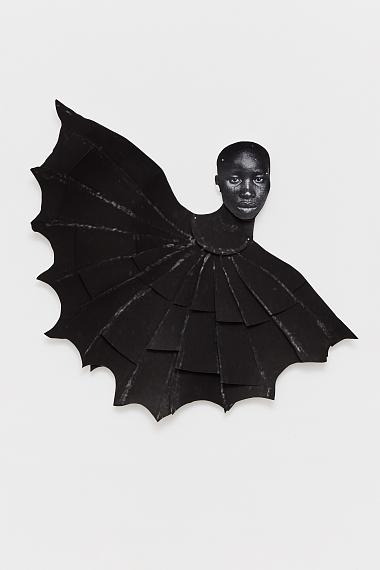
Batwoman, 2021
Collage with paper pins mounted
© Frida Orupabo
Courtesy of the artist and Galerie Nordenhake, Berlin, Stockholm, Mexico City
Finalist*innen des Deutsche Börse Photography Foundation Prize 2023
Bieke Depoorter, Samuel Fosso, Arthur Jafa und Frida Orupabo
Der 1996 ins Leben gerufene und seit 2016 in Partnerschaft mit der Photographers’ Gallery in London verliehene einflussreiche Prize zeichnet jährlich Künstler*innen und ihre Projekte aus, die in den vergangenen 12 Monaten den bedeutendsten Beitrag zur Fotografie geleistet haben.
In seiner mittlerweile 26-jährigen Geschichte hat sich der Prize zu einer der international renommiertesten Auszeichnungen für Fotograf*innen entwickelt. Zugleich dient er als wichtiges Barometer für die Entwicklung des fotografischen Mediums sowie für herausragende, innovative und zum Nachdenken anregende Positionen. Die Finalist*innen reizen die Grenzen des fotografischen Mediums aus und bezeugen eindrucksvoll dessen Widerhall und Relevanz als kulturelle Kraft von heute. Die Bandbreite ihrer Projekte reicht vom Verwischen der Beziehung zwischen Fotograf*in und Motiv und dem Entschlüsseln einer Ethik des Fotografierens bis hin zur Erforschung von Geschlecht und Sexualität, Gewalt, Ungerechtigkeit und Schwarzer Erfahrung.
Die jährliche Ausstellung der ausgewählten Projekte wird vom 3. März bis 11. Juni 2023 in The Photographers’ Gallery, London, zu sehen sein.
Der*die Gewinner*in der Auszeichnung wird im Rahmen einer Preisverleihung am 11. Mai 2023 in der Photographers’ Gallery bekannt gegeben und erhält 30.000 £ als Preisgeld. Die anderen drei Finalist*innen erhalten jeweils 5.000 £. Einzelheiten zur Ausstellung und Preisverleihung werden Anfang 2023 veröffentlicht.
Die ausgewählten Finalist*innen 2023 und ihre Projekte sind:
Bieke Depoorter – für ihre Ausstellung "A Chance Encounter" im C/O Berlin (30. April – 7. September 2022)
In der Präsentation, die Installationen, Projektionen, Filme und Fotografien umfasst, lässt Bieke Depoorter (* 1986, Kortrijk, Belgien) das traditionelle Verhältnis zwischen Fotograf*in und Motiv unscharf werden. Die Ausstellung präsentiert mit "Agata" und "Michael" zwei fortlaufende Arbeiten, die sich über mehrere Jahre hinweg aufbauen. Eine zufällige Begegnung entwickelt sich zu einer anhaltenden persönlichen Beziehung und daraus folgend einer Befragung des Mediums der Fotografie.
In "Michael" beschäftigt sich Bieke Depoorter mit dem Leben und dem Verschwinden eines Mannes, den sie 2015 auf den Straßen von Portland, Oregon, kennengelernt hat. Nachdem er ihr drei Koffer mit persönlichen Gegenständen, Skizzenbüchern und Essays überlässt, wird Depoorter zur akribischen Detektivin. Die Ausstellung dokumentiert ihre intensive – und möglicherweise obsessive – Spurensuche in dem Bemühen, Michael aufzufinden und sein Leben zu verstehen.
In "Agata" – sowohl in der Ausstellung als auch im von der Künstlerin produzierten Fotobuch – entfaltet sich eine erste Begegnung in einem Pariser Striptease-Lokal 2017 zu einem ebenso spannungsgeladenen wie komplexen Versuch der Kollaboration. Hier treten Porträts und Worte von Agata Kay in einen intensiven Dialog mit Depoorters Bildern und brieflichen Äußerungen. Sie bieten keine abschließenden Erkenntnisse, sondern eine lebendige, abwechslungsreiche visuelle Erzählung, die Konzepte authentischer bzw. performativer Identität erforscht. In "Agata" geht es um die Möglichkeit oder Unmöglichkeit von Wahrheit in der Darstellung, um den Spielraum künstlerischer Autor*innenschaft und ethischer Verantwortung der Fotografierenden, persönliche Abgrenzungen, aber auch die Grenzen einer künstlerischen Freundschaft.
Samuel Fosso – für seine Retrospektive "Samuel Fosso" in der Maison Européenne de la Photographie, Paris (10. November 2021 – 13. März 2022)
Seit Mitte der 1970er Jahre widmet sich Samuel Fosso (* 1962, Kumba, Kamerun) dem Selbstporträt und der performativen Fotografie. Die Retrospektive zeichnet eine fast 50-jährige Karriere künstlerischer Praxis nach und umfasst mehr als 300 Abzüge. In der Ausstellung finden sich berühme Fotoserien, aber auch weniger bekannte Arbeiten, Archivmaterial und bislang unveröffentlichte Bilder, die vor allem in großformatigen Ensembles gezeigt werden.
Der in Kumba, Kamerun, geborene und in Nigeria aufgewachsene Künstler floh als kleiner Junge vor dem Biafra-Krieg und kam 1972 bei einem Onkel in Bangui in der Zentralafrikanischen Republik unter. 1975, im Alter von 13 Jahren, eröffnete Samuel Fosso sein Studio Photo Nationale. Neben kommerziellen Aufträgen begann er sofort mit einer Serie von Selbstporträts – eine Darstellungsform, die Fosso nie wieder aufgegeben hat. Indem er vor der Kamera in die Rolle von bedeutenden historischen Figuren oder gesellschaftlichen Archetypen schlüpft, verkörpert der Künstler eine kraftvolle Art, in der Welt zu existieren und demonstriert zugleich anschaulich die Rolle der Fotografie in der Konstruktion von Mythen.
Arthur Jafa – für seine Ausstellung "Live Evil" im LUMA, Arles (14. April – 13. November 2022)
Der Künstler und Filmemacher Arthur Jafa (* 1960, Tupelo, USA) wurde für die bislang größte und umfangreichste Ausstellung seines Werks als Finalist ausgewählt. Jafa schöpft aus einem gewaltigen Archiv von Film- und Standbildern und schafft emotional durchdringende, hochdynamische Filme und raumfüllende Installationen.
Seine Überzeugungskraft bezieht Jafa im Ausstellungsraum wie auf der Leinwand aus der geschickten Gegenüberstellung und einer lyrischen, synkopischen Montage. Hier kommen die Bedeutung seines persönlichen Archivs und sein Instinkt als Bildersammler zum Tragen: Seit den 1980er Jahren sammelt Jafa Bilder aus Büchern und Zeitschriften, montiert sie in Alben und arrangiert dieses Bildmaterial zunächst in seinen Notizbüchern und später in dynamischen Kunstprojekten immer wieder neu. Neben Aufnahmen für Nachrichtenmedien und privaten Videos greift er bevorzugt auf YouTube zurück.
Indem er kulturelle Artefakte mit ihren Resonanzen nebeneinanderordnet, verweist der Künstler auf universelle und spezifische Ausdrucksformen Schwarzer Erfahrung und stellt sie zugleich infrage. Er verzichtet auf eine lineare Erzählung und organisiert sein Material anhand formaler und affektiver Assoziationen, indem er seine Bilder durch visuelle Ähnlichkeit oder thematische Widerklänge miteinander verknüpft. Auf diese Weise zielt Arthur Jafa auf eine Kunst, die sich "die Kraft, die Schönheit und die Entfremdung Schwarzer Musik" zunutze macht.
Frida Orupabo – für ihre Ausstellung "I have seen a million pictures of my face and still I have no idea" im Fotomuseum Winterthur (26. Februar bis 29. Mai 2022)
Bei den skulpturalen Collagen und digitalen Arbeiten von Frida Orupabo (* 1986, Sarpsborg, Norwegen) handelt es sich um vielschichtige Formationen, die sich mit Fragen nach Race, Sexualität und Identität auseinandersetzen. Die norwegisch-nigerianische Künstlerin und Soziologin stützt ihre Untersuchung dabei auf eigene Erfahrungen von kultureller Zugehörigkeit.
Unter Verwendung von kursierendem Material aus dem Internet, das von Fotografien aus der Kolonialzeit und ethnografischen Reliquien bis hin zu zeitgenössischem Bildmaterial reicht, ordnen Orupabos handgefertigte Arbeiten das Archiv neu an und gestalten es um. Die daraus resultierenden Bilder haben die Form fragmentierter Schwarzer – meist weiblicher – Körper. Diese zunächst zerschnittenen Gestalten werden nun in einem ausgefeilten poetischen Verfahren Schicht für Schicht so zusammengefügt, dass eindimensionalen Darstellungen Schwarzen Lebens eine Absage erteilt wird. Orupabo gesteht ihm vielmehr Komplexität, Ambivalenz und Widersprüchlichkeit zu. Ihre collagierten Ausschnitte fangen unseren Blick ein und ermöglichen ganz unterschiedliche Lesarten der Geschichten und des Lebens der abgebildeten Personen, von denen etliche in den geläufigen Archiven gar nicht vorkommen. Auf diese Weise lädt die Künstlerin zu einer Betrachtung darüber ein, wie stark die Fotografie zur Bildung und Fortschreibung kolonialer Machtverhältnisse und Gewalt beiträgt.
Die Jury 2023 und ihre Begründungen:
Die diesjährige Jury setzt sich zusammen aus: Thyago Nogueira, Leiter des Bereichs Contemporary Photography am Instituto Moreira Salles, São Paulo; Natalie Herschdorfer, Direktorin des Photo Elysée, Lausanne; Mahtab Hussain, Künstler; Anne-Marie Beckmann, Direktorin der Deutsche Börse Photography Foundation, Frankfurt/Main, sowie Brett Rogers, OBE, Direktorin der Photographers’ Gallery, London, als stimmberechtigte Vorsitzende.
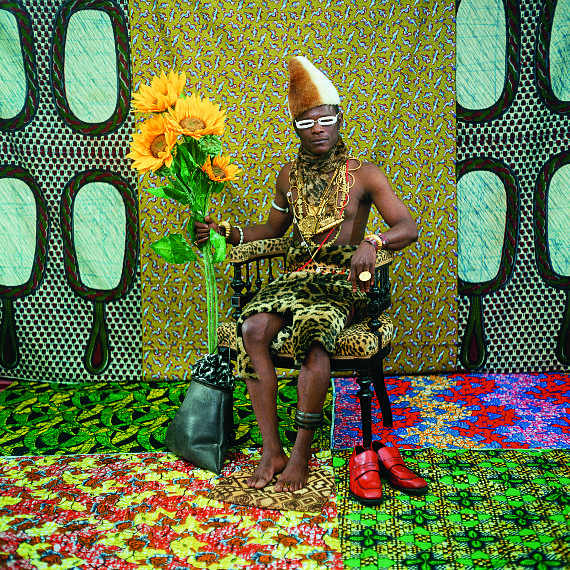
The Chief who Sold Africa to the Colonists, 1997
© Samuel Fosso
Courtesy of the artist and JM Patras, Paris